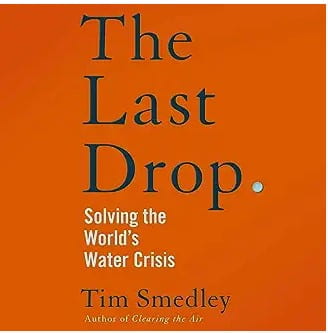Solving the world’s water crisis
This was a fascinating book with lots of facts and numbers about running out of water in places all over the world and some of the solutions to this problem. The only issue for me was that the balance between the two was heavily weighted in favour of telling us how bad it was again and again with not enough solutions – really these only came in the last two chapters.
I am fascinated by this issue of water and have been taking steps on my allotment to try and work out how I would cope if the water at the site was turned off because the drought was so bad. We have bore hole water and so hose pipe bans are limited for us but I can’t help thinking that we really shouldn’t be using drinking quality water on our vegetables. We should be using collected water as we get plenty of rain over the winter period. Anyway, the solutions in this book were for much more water than I need but the principle that came over was localised solutions and often nature could solve the problem for a fraction of the cost of big technology.

We are stealing water through overextraction, pollution and underinvestment, just listen to the water companies at present. Neither the shareholders nor CEOs are underinvested but they have been guilty of focusing on the wrong priority. Their priority is clean water not just to drink but in our rivers and seas and so water problems are not just about quantity but also in this country about quality. The companies release sewage every time it rains, usually later at night instead of dealing with it. It is public outrage that has brought this to everyone’s attention, not the politicians, and it will be the people who solve the problem.
Some of the solutions that interested me were:
- Regenerative agriculture – the idea of no-till or no-dig on our allotments has been shown to produce a soil that has a far greater water-holding capacity than a soil that is tilled or that is just organic but tilled. In this way of farming/gardening, soil is not left uncovered with a focus on the soil micro-organisms being of great importance. Southern Water is now paying farmers to farm in this way as it prevents flooding.
- Rain water harvesting built into all new-builds. Other countries do it, so should we. Chloe Whipple spent a year living on 15litres of mains water a day – your average Brit uses 150litres a day. The trick is to build systems that make a reduced water usage feel luxurious rather than a chore. Simple things might be a shower head that mixes air and water to reduce the water flow or even just to take a bucket into the shower to catch water that doesn’t hit you and disappears down the drain.
- Beavers. Yes – they manage water flow, building dams that ensure water floods over nearby land – otherwise known as a flood plain – and drains away slowly. It’s just that we have built on flood plains. We have our very own trial down here on the River Otter
- In places such as California, covering water canals with solar panels is a win-win. Energy is produced, evaporation of water is reduced and the water helps to cool the panels.
- Capturing road run-off and diverting it to planting to allow it to soak into the land. These are sometimes known as rain gardens but the king of this is is Tucson, Arizona, Brad Lancaster who lives and breathes what he preaches.
Permaculture has always said that the cheapest place to store water is in the soil. How true that is.
